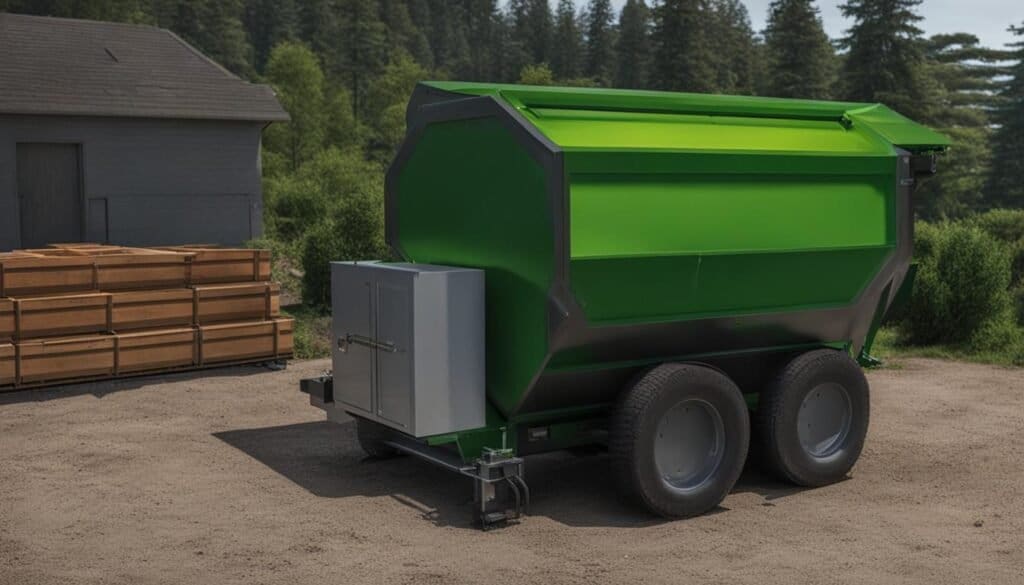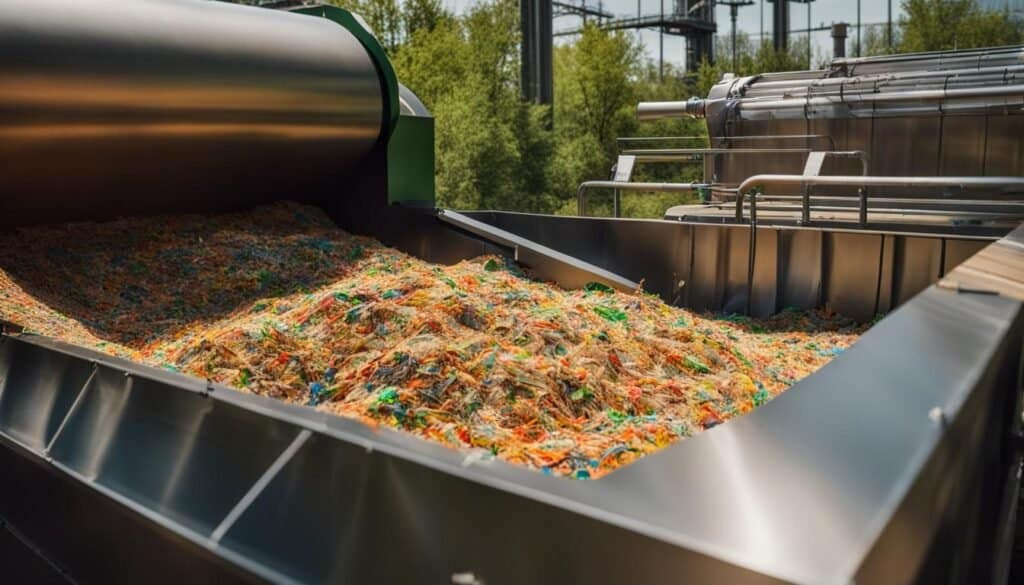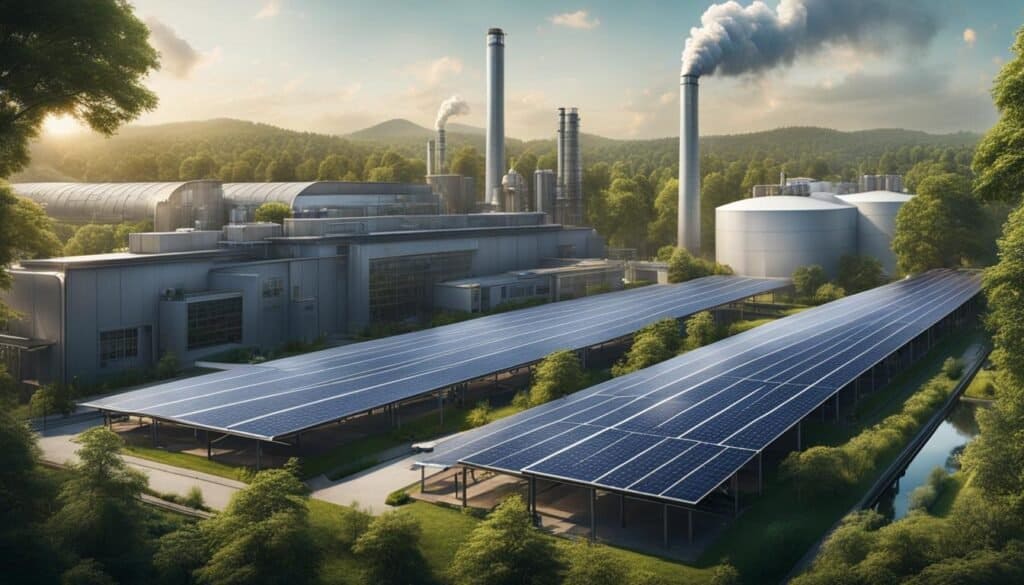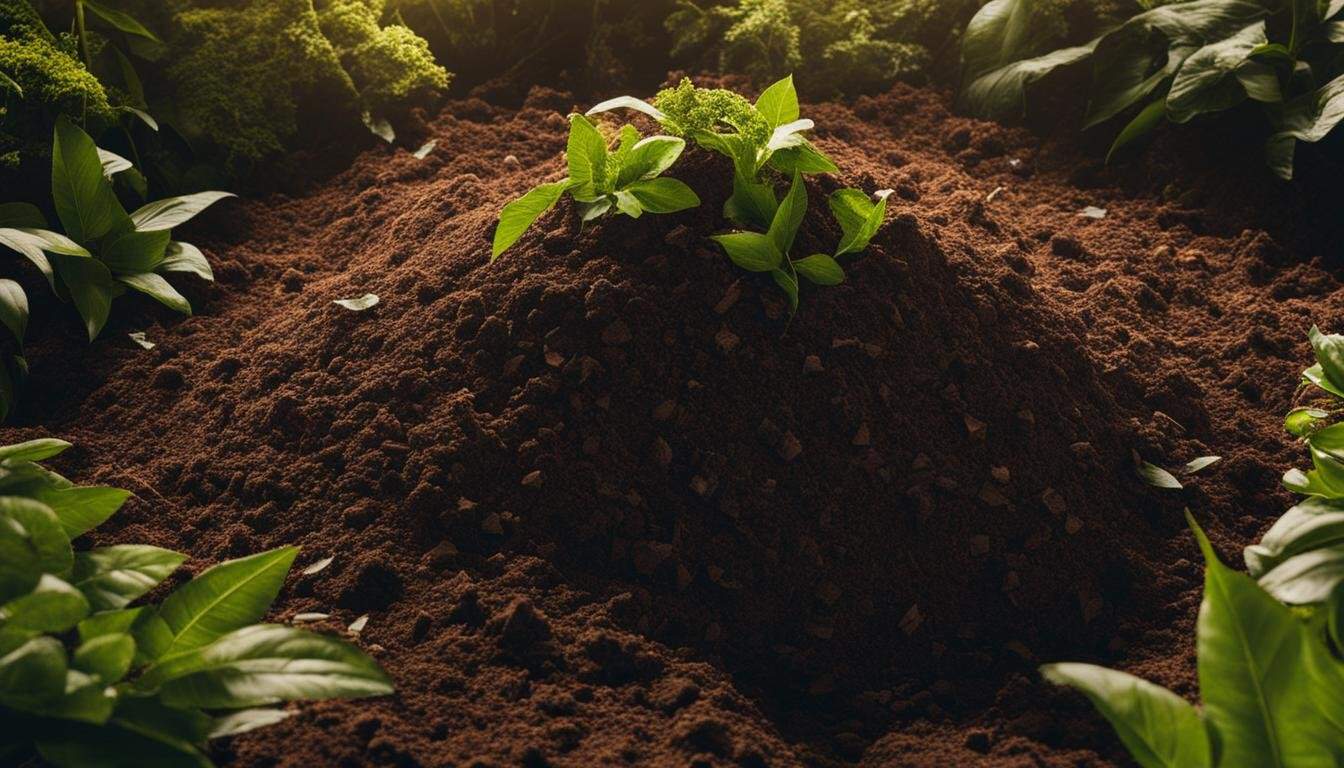As an advocate for environmental sustainability, I am excited to share with you the benefits of incorporating biodegradable products and compostable materials into our daily lives. With a strong focus on eco-friendly alternatives, we can pave the way towards a sustainable future filled with green products with a positive environmental impact.
These innovative solutions contribute to reducing landfill waste, lessening plastic pollution, and promoting using renewable resources and organic waste management practices. So, let’s explore the world of compostable and biodegradable products and their undeniable role in securing a healthier planet.
Key Takeaways
- Biodegradable products and compostable materials offer an eco-friendly alternative to traditional, non-biodegradable items.
- Switching to these sustainable options can drastically reduce landfill waste and plastic pollution.
- Both individuals and businesses can make a significant environmental impact by embracing green products and practices.
- Understanding the differences between compostable and biodegradable materials is essential for making informed purchasing decisions.
- Corporate responsibility and consumer awareness are paramount in promoting the use of renewable resources and organic waste management practices.
Understanding Compostable and Biodegradable Materials
To foster sustainable living and environmental conservation, it’s crucial to understand what compostability and biodegradation mean, how they differ, and the materials commonly used to create eco-friendly products.
Approximately 90% of plastic products are used once and then discarded, creating a global environmental crisis, with 6.3 billion tonnes of plastic waste produced worldwide and 79% of plastic waste stored in landfills. Nature Communications
By using items manufactured with bio-based materials and plant-based products, we can reduce landfill waste, shrink our carbon footprint, and support responsible green consumerism.
Defining Compostability and Biodegradation
Compostability is the ability of materials to decompose into non-toxic substances, such as carbon dioxide, water, inorganic compounds, or biomass, by the enzymatic action of microorganisms under specific conditions. Biodegradation, conversely, refers to the natural breakdown process of materials by microbial action, which can be influenced by factors like moisture, temperature, and the material’s chemical structure. Both processes are measured by standardized tests according to ASTM standards, ensuring consumers can trust eco-friendly products’ environmental safety claims.
Biodegradable vs. Compostable – What’s the Difference?
Despite sharing the goal of environmentally safe decomposition, biodegradable and compostable materials differ in their certification and specific decomposition abilities. Compostable materials must break down at a rate consistent with known compostable items like cellulose, producing quality compost and meeting standards, such as ASTM D6400.
Biodegradable products, however, may vary in decomposition rates and environments. Microorganisms must fully utilize biodegradable materials without leaving potentially harmful residues to ensure environmental sustainability.
Common Materials Used in Eco-Friendly Products
Eco-friendly products often use materials like plant-based plastics, compostable films, and paper-based alternatives for packaging. Examples of these sustainable materials and products include:
- Compostable packaging: Replacing conventional plastic packaging products with compostable alternatives
- Biodegradable utensils: Eliminating traditional single-use plastics and opting for biodegradable cutlery
- Natural fibers: Producing textiles using materials such as bamboo, hemp, or organic cotton
- Bioplastics: Replacing petrochemical-based plastics with plant-based alternatives derived from renewable natural resources
These materials promote sustainability, provide an eco-friendly alternative to finite and contaminating resources, and align with the global movement toward green consumerism and sustainable living practices.
The Role of Bioplastics in Sustainable Development
Bioplastics play a crucial role in sustainable development by offering an alternative to conventional petrochemical-based plastics. Made from renewable resources, such as cornstarch or sugarcane, bioplastics can potentially reduce the environmental footprint of products throughout their lifecycle.
Sustainable packaging materials made from bioplastics are being developed to complement recycling and composting systems, aiding in preserving ecological balance, promoting zero-waste strategies, and creating green solutions that contribute to a more sustainable future. These innovative materials present diverse opportunities to address the pressing need for more eco-friendly solutions in various industries.
Not all bioplastics are biodegradable, and some biodegradable plastics are fully petroleum-based. The terms “bioplastic” and “biodegradable plastic” are not synonymous. Wikipedia
A product lifecycle analysis helps assess a product’s environmental impact from its inception to its disposal. This comprehensive examination encompasses raw material extraction, manufacturing, distribution, use, and end-of-life management. By utilizing bioplastics, businesses can actively work towards reducing their overall environmental footprint and promoting sustainable practices throughout the entire product lifecycle.
- Production: bioplastics utilize renewable resources, reducing the dependency on fossil fuels and enabling a more sustainable production process.
- Use: products made from bioplastics often have a minor environmental impact due to their biodegradation capabilities and decreased reliance on petrochemicals.
- End-of-life: bioplastics can be recycled or composted, reducing the burden on landfill disposal sites and waste management facilities.
Bioplastics also offer sustainable packaging options, providing a greener alternative to conventional packaging materials. Bioplastics can biodegrade more quickly and efficiently than traditional plastic packaging, reducing waste accumulation and fostering a zero-waste vision.
| Traditional Plastic Packaging | Bioplastic Packaging |
|---|---|
| Petrochemical-based | Derived from renewable resources |
| Non-biodegradable or slow to degrade | Faster and more efficient biodegradation |
| Leads to landfill waste accumulation | Reduced waste accumulation |
| Contributes to plastic pollution | Lowers the risk of plastic pollution |
| Resource-intensive production process | Potentially lower environmental impact |
Adopting bioplastics promotes sustainable development by replacing conventional plastic materials with renewable and more environmentally friendly alternatives. Their utilization across various industries signifies a positive shift towards ecological balance, zero waste, green solutions, and sustainable packaging. By embracing bioplastics, businesses and consumers can contribute to a more sustainable future and drive the development of innovative, eco-friendly solutions.
Evaluating the Benefits of Compostable and Biodegradable Items
Understanding the numerous benefits of compostable and biodegradable products is crucial for responsible consumer choices and sustainable practices. These eco-friendly materials reduce landfill waste, enhance soil health, and help decrease plastic pollution.
Reducing Landfill Waste Through Biodegradables
Integrating biodegradable items into consumer products can significantly reduce landfill waste. Since these products decompose naturally, they return to the environment as organic matter instead of persisting in landfills for extended periods.
When people embrace biodegradables, they support waste management solutions focused on minimizing the harmful environmental effects of landfill accumulation. This eco-responsibility offers ecological and economic benefits by enhancing waste processing and conserving valuable resources.
How Compostables Contribute to Soil Health
Compostable products are vital in improving soil health by functioning as natural fertilizers when they decompose. Enriched soil promotes sustainable agriculture initiatives, ensuring the Earth’s biome thrives. Opting for compostable materials over traditional, non-biodegradable options minimizes reliance on artificial additives and helps conserve natural resources. It also supports eco-friendly manufacturing processes and encourages sustainable agricultural practices.
Diminishing Plastics Pollution with Green Alternatives
Replacing traditional plastics with green alternatives is vital to diminishing plastics pollution. Sustainable materials, such as biodegradable or compostable products, offer tangible solutions for reducing ecosystem pollution.
Transitioning to green alternatives lessens the presence of environmental contaminants and supports the adoption of an eco-lifestyle. By choosing sustainable materials, consumers also incentivized to use renewable energy and resources, leading to a far-reaching positive environmental impact.
“By opting for green alternatives, we are not only reducing the pollution caused by traditional plastics but also taking a step towards a more eco-conscious lifestyle.”
Ultimately, the integration of biodegradable and compostable items in our daily lives can make a significant impact on fostering environmental sustainability. Through informed choices and eco-friendly practices, we can collectively work towards reducing landfill waste, improving soil health, and diminishing plastics pollution to create a cleaner, greener future.
Industrial vs Home Composting: Compostable Product Management

In our quest for environmental sustainability and waste reduction, one of the critical factors to consider is how we manage compostable products. Both home and industrial composting methods offer unique benefits and challenges when it comes to compostable plastics and organic waste management.
Methods of Composting and its Impact on Biodegradability
Home composting allows environmentally conscious individuals to manage their organic waste using compost bins or heaps. This method is ideal for handling everyday kitchen scraps, such as fruit peelings, vegetable trimmings, and coffee grounds. Although accessible to the average homeowner, home composting may not provide the optimal conditions for biodegrading certain compostable plastics, often requiring higher temperatures or longer decomposition periods.
On the other hand, industrial composting facilities can handle larger volumes of organic materials and a wider variety of compostable plastics. They employ controlled environments with specific temperatures and moisture levels that accelerate biodegradation. This method helps create nutrient-rich compost that can be used for organic farming and soil improvement, further highlighting the importance of sustainable practices in waste management.
Both home and industrial composting methods have a significant impact on the biodegradation of compostable products, ultimately contributing to waste reduction, environmental sustainability, and soil health.
Barriers to Composting Infrastructure and Public Participation
Despite the advantages of compostable products, some barriers limit the full potential of composting infrastructure and public participation. Some of these challenges include:
- Limited access to composting facilities
- Lack of public awareness and education on composting methods
- Insufficient regulatory support for home and industrial composting
Overcoming these barriers entails fostering green initiatives, promoting community engagement in sustainable practices, and encouraging the use of eco-conscious goods. Conservation efforts and sustainable waste management systems can be reinforced by investing resources into making composting facilities more accessible, raising public awareness, and implementing regulations that support sustainable practices.
| Composting Method | Pros | Cons |
|---|---|---|
| Home composting | Accessible, convenient, manageable for small-scale organic waste | May not break down certain compostable plastics, limited in capacity |
| Industrial composting | Handles large volumes, can process a variety of compostable plastics, produces high-quality compost for farming | Less accessible, may require greater investment and public education initiatives |
The successful management of compostable products hinges on a comprehensive understanding of industrial and home composting methods. Striving to remove barriers and promote public participation in sustainable waste management practices will pave the way for a greener environment and a more sustainable future.
Environmental Footprint: The Production Process of Eco-Friendly Goods
The production process of eco-friendly goods is critical in reducing the environmental footprint. By incorporating sustainable materials, employing green manufacturing, and leveraging green technology, companies can lessen the environmental impact and carbon footprint of goods throughout their lifecycle.
Producers of eco-friendly goods are committed to a zero-waste philosophy, striving to conserve natural resources and promote responsible production practices. They rely on several innovative strategies to ensure a sustainable and environmentally conscientious production process.

- Sustainable materials: By selecting materials that are biodegradable, recyclable, or derived from renewable resources, producers can reduce their dependence on nonrenewable resources and minimize the environmental impact of their goods.
- Carbon footprint reduction: Implementing energy-efficient production methods and utilizing renewable energy sources can help reduce a company’s carbon footprint dramatically, mitigating greenhouse gas emissions during production.
- Green manufacturing: Adhering to the principles of green manufacturing ensures that every stage of the production process is environmentally responsible – from resource extraction and processing to final product assembly and packaging.
- Zero waste: Incorporating zero waste strategies into the production process can minimize waste generation, encourage recycling and reuse, and reduce overall resource consumption.
- Natural resources conservation: By reducing material and energy usage and employing eco-friendly manufacturing techniques, producers can contribute significantly to conserving natural resources.
“Sustainability, ensuring the future of life on Earth, is an infinite game, the endless expression of generosity on behalf of all.” – Paul Hawken
As global sustainability goals gain traction, companies must embrace eco-friendly practices, making a concerted effort to reduce their environmental footprint. One way to illustrate the impact of these practices is by comparing conventional and green manufacturing processes. The table below highlights differences between traditional and eco-friendly production processes regarding resource consumption and emissions.
| Conventional Production | Green Production | |
|---|---|---|
| Resource Consumption | High resource usage, leading to depletion of nonrenewable resources | Reduced resource consumption through sustainable materials and efficient production methods |
| Energy Efficiency | Higher energy consumption, often heavily reliant on fossil fuels | Improved energy efficiency and increased use of renewable energy sources |
| Greenhouse Gas Emissions | Significant emissions, contributing to climate change | Reduced emissions through cleaner production processes and carbon footprint reduction |
| Waste Generation | High levels of waste, limited recycling and reuse | Minimized waste through zero waste strategies and recycling initiatives |
Green production methods and eco-friendly goods are essential for mitigating our numerous environmental challenges. By adopting these sustainable methods, companies can reduce their environmental footprint, support global sustainability goals, and create a brighter future for our planet and all its inhabitants.
Consumer Shift: Embracing Eco-Friendly Products for a Greener Tomorrow
As the world grapples with mounting environmental challenges, a perceptible consumer shift towards sustainable goods is evident. This trend, powered by a heightened awareness of environmental conservation and a desire for sustainable living, has significant implications for consumers and businesses. The increasing demand for biodegradable or compostable alternatives emphasizes the importance of eco-responsibility, promoting the adoption of conservation-based practices and energy-efficient solutions.
The Increasing Demand for Sustainable Goods
Today’s environmentally conscious consumers have paved the way for a growing appetite for eco-friendly products. As more individuals adopt green consumer habits, businesses increasingly invest in eco-design and innovative, sustainable solutions.
As a result, eco-conscious products are gradually infiltrating various market segments, driving demand for sustainable packaging, eco-responsible services, and energy-efficient products. This phenomenon is changing the landscape of contemporary consumerism, fostering a more environmentally responsible culture.
Making Informed Choices: Identifying Truly Eco-Friendly Products
For eco-conscious consumers, making informed choices when shopping for sustainable products is essential. This involves understanding environmental impact labels, seeking green product certification, and vigilance of greenwashing attempts. By evaluating the packaging, product design, and materials used, consumers can effectively identify eco-conscious goods, such as products made with biodegradable plastics or recycled materials, contributing to an increasingly responsible consumer culture.
Being eco-conscious doesn’t just mean buying sustainable products – it also involves educating oneself on the environmental impact of various products, asking the right questions, and continuously striving to make the most informed choices possible.
Ultimately, the consumer shift to embrace eco-friendly products transforms how we live, work, and play. As individuals and businesses prioritize environmental conservation and adopt sustainable living practices, we move closer to a greener tomorrow.
Corporate Responsibility and Eco-Conscious Business Practices
The ongoing necessity for environmental sustainability has steered businesses towards implementing corporate responsibility and adopting eco-conscious business practices. A significant aspect of these practices involves sustainable manufacturing, green technology in production, and renewable resources.
Companies that have embraced these practices illustrate the effectiveness of environmental stewardship, eco-friendly manufacturing, and conservation efforts in promoting a more sustainable future.
How Businesses are Adapting to Sustainable Manufacturing
More and more businesses are adopting eco-friendly strategies for their operations, including sustainable production. By optimizing their use of renewable resources, these businesses contribute to a sustainable supply chain and minimize the overall environmental impact of their products. Prioritizing environmental stewardship in their operations highlights the ethical commitment of these companies to preserving the planet while simultaneously generating economic benefits.

The Growth of Green Technology in Production and Packaging
Green technology is experiencing considerable growth in production and packaging processes, with recent innovations finding applications across different industries. Packaging innovations, such as compostable films or plant-based materials, reflect the commitment to environmental preservation and signify the importance of eco-responsibility throughout various sectors of industry and consumerism.
Eager to integrate eco-friendly alternatives, various companies are incorporating sustainable materials into their products and packaging. This growing trend highlights the need for environmentally mindful innovation, renewable energy, and environmentally friendly practices.
A noteworthy example of the growth of green technology is the use of sustainable materials in car manufacturing. Many car manufacturers now incorporate biodegradable or compostable materials into their vehicles, setting new standards for environmental responsibility and conservation in the automotive industry.
- Streamlined production processes to minimize waste and energy consumption
- Utilization of biodegradable and compostable materials in product design and packaging
- Integration of renewable energy sources in manufacturing facilities
| Industry | Green Technology Application |
|---|---|
| Automotive | Biodegradable and recycled materials in vehicle interiors |
| Packaging | Compostable films and plant-based packing materials |
| Textiles | Sustainable and environmentally friendly fabrics |
| Consumer Electronics | Recycled materials in new devices |
Many companies are recognizing the necessity of corporate responsibility and eco-conscious business practices. As more businesses embrace sustainable manufacturing and green technology in production, the global push towards a more sustainable future gathers momentum and inspires further innovation in all areas of industry.
Challenges and Misconceptions Surrounding Biodegradable Products

Biodegradable products have gained significant traction recently, with consumers and businesses striving to minimize their environmental impact. However, several challenges and misconceptions about biodegradables can hinder their practical use and potential benefits. This section will address some of the most common misconceptions and discuss the importance of sustainable product education to promote transparency and achieve sustainable development goals.
Misunderstanding the science behind biodegradable materials: The intricacies of biodegradable materials science can perplex the average consumer, leading to misconceptions about the actual environmental benefits of some products.
For instance, people often do not realize that not all biodegradable materials are created equal, with some breaking down more readily than others and at varying rates under different conditions. A lack of understanding about these nuances can lead to unrealistic expectations and disappointment.
Unrealistic expectations of product performance: Consumers may be drawn to biodegradable products, believing they will break down quickly and completely, presenting a perfect solution to waste management problems. However, the environmental impact assessment of biodegradable items is more complex than meets the eye, and even products marketed as eco-friendly may fail to deliver on their promises under certain circumstances.
“Greenwashing” is a significant concern, with some companies leveraging vague or misleading claims to promote their products as environmentally friendly while failing to provide clear information on how they actually minimize environmental impact. As a result, consumers may inadvertently purchase items that do not offer the expected benefits, perpetuating the problem rather than contributing to a solution.
The following table highlights the differences between some common biodegradable materials:
| Material | Decomposition Timeline | End-of-Life Conditions |
|---|---|---|
| Paper | 2-6 weeks | Decomposes fully in landfill or composting facilities |
| PLA (Polylactic Acid) | 6-24 months | Decomposes fully in industrial composting facilities under specific conditions, but may not break down effectively in home compost or landfill |
| Oxo-biodegradable plastics | Variable, often taking several years | Partially decomposes into smaller plastic fragments, which can persist in the environment and cause harm to ecosystems |
Eco-friendly product transparency and education: Reliable information is essential for consumers to make informed choices about the products they buy and the companies they support. Organizations such as the Federal Trade Commission (FTC) provide guidelines for avoiding deceptive environmental claims and promoting market transparency. Still, many consumers remain unaware of the regulatory criteria that define genuinely environmentally friendly products.
- Seek reputable certifications, such as the OK Compost.
- Research the manufacturer and the materials used in a product.
- Learn about proper disposal methods, such as composting or recycling, to maximize a product’s eco-friendly potential.
By addressing these misconceptions and challenges, we contribute to achieving sustainable development goals and ensuring the proper use and disposal of eco-friendly products. Education and transparency are essential to promote a more sustainable future as consumers and businesses continue to adopt biodegradable and compostable solutions.
Conclusion
Biodegradable products and eco-friendly practices play crucial roles in our journey towards a sustainable future and environmental preservation. These green alternatives have the potential to transform industries and individual lifestyles alike, providing a pathway to reduce waste, conserve resources, and lessen pollution. By incorporating eco-friendly practices into the various aspects of our lives, we can achieve an equilibrium in ecological balance, helping to bring us closer to a sustainable world and a zero-waste vision.
Educating ourselves about the true environmental impact of our products remains paramount. Informed consumerism and responsible corporate behavior empower us to create a greener tomorrow. As we embrace this shift towards sustainability, we must remain mindful of misconceptions and greenwashing tactics, seek genuine eco-friendly options, and support businesses prioritizing sustainability in their operations.
Ultimately, our collective actions as individuals, businesses, and communities determine the success of global sustainability efforts. By adopting and promoting green living, we can preserve our planet’s natural resources for current and future generations. Let’s work together to create a more sustainable world, building on the foundation of biodegradable products, eco-friendly practices, and overall environmental responsibility.
FAQ on Biodegradable Products
Q: What does biodegradable mean in relation to products such as plastic and paper?
A: Biodegradable means that a product, like plastic or paper, can be broken down naturally by microorganisms such as bacteria and fungus, returning to the natural environment without causing harm. These types of products break down into components like water, carbon dioxide, and biomass.
Q: What is a list of biodegradable materials commonly used in food packaging?
A: Common biodegradable materials used in food packaging include starch-based packing peanuts, PLA (Polylactic Acid) cups and containers, biodegradable plastics created from potato starch, and biodegradable paper products. It is important to note that while these products are biodegradable, effective disposal methods are required to ensure they break down efficiently.
Q: Can you elaborate on the term BPI and how it affects biodegradable products?
A: The term BPI stands for Biodegradable Products Institute. It is a recognized institute that offers a certification program for manufacturers of compostable plastic products. If a product is BPI-certified, it means it has been scientifically tested and proven to be compostable in professional composting facilities.
Q: Where can I buy biodegradable and compostable products?
A: You can buy biodegradable and compostable products in many grocery and online stores. Look for products marked ‘biodegradable’ or ‘compostable’ and preferably with a BPI-certification. Using biodegradable products can significantly reduce plastic waste and contribute to a healthier environment.
Q: How can I tell if something is biodegradable, compostable or merely disposable?
A: The term disposable simply means that the product is designed for one-time use and then it’s meant to be thrown away. A biodegradable or compostable item, on the other hand, is designed to break down over time by the action of microorganisms. Look for terms such as “BPI-certified compostable,” “100% biodegradable,” or similar on the packaging. Also, each type of product requires a different disposal method to ensure its environmental impact is minimal.
Q: How does food waste factor into the biodegradability process?
A: Food waste can also be biodegradable. When disposed of properly, food waste effectively breaks down within composting facilities and forms a nutrient-rich soil conditioner. As much as possible, food waste should be separated from non-biodegradable waste and disposed of in compostable facilities.
Q: Do biodegradable products contribute to plastic waste?
A: Properly disposed biodegradable products do not contribute to plastic waste as they are designed to break down into water, carbon dioxide, and biomass, reducing their environmental impact. However, if they are not correctly disposed of, for instance in a landfill, they may not decompose efficiently and can contribute to waste. It is therefore crucial to follow appropriate disposal methods.
Q: What are some of the dangers of using non-biodegradable products?
A: Regular use of non-biodegradable products, especially plastic products, causes significant harm to the environment. As these products do not break down naturally, they accumulate in landfills, oceans, and other ecosystems, harming wildlife and contributing to pollution. Their manufacturing process also contributes to global warming and resource depletion.
Q: What is the difference between biodegradable, compostable, and oxo-degradable products?
A: Biodegradable products are able to break down naturally over time by the action of microorganisms. Compostable products also break down into water, carbon dioxide and biomass, but in addition, they are certified (e.g., BPI-certified) to break down within specific composting environments. On the other hand, Oxo-degradable products are plastic bags or film made from polyolefin with added amounts of metal salts. These products degrade when subjected to heat and sunlight but may leave behind microplastics, which have their environmental challenges.
Q: What are some advantages of using biodegradable and compostable materials over regular plastic bags and other such products?
A: Biodegradable and compostable materials offer an environmentally friendly alternative to traditional plastic bags and other such products. They are designed to break down over time without causing harm to the environment. This can significantly reduce the accumulation of waste in landfills and oceans, leading to a healthier, more sustainable world. Always ensure to dispose of these materials in appropriate facilities to ensure they break down efficiently.





Leave a Reply